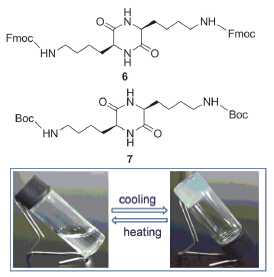| [1] Steed, J. W. Chem. Commun. 2011, 47, 1379.
[2] Suzaki, Y.; Taira, T.; Osakada, K. J. Mater. Chem. 2011, 21, 930.
[3] Hanabusa, K.; Suzuki, M. Polym. J. 2014, 46, 776.
[4] Plekan, O.; Feyer, V.; Ptasinska, S.; Tsud, N.; Prince, K. C. Phys. Chem. Chem. Phys. 2014, 16, 6657.
[5] Xie, Z. G.; Zhang, A. Y.; Ye, L.; Wang, X.; Feng, Z. G. J. Mater. Chem. 2009, 19, 6100.
[6] Adams, D. J.; Butler, M. F.; Frith, W. J.; Kirkland, M.; Mullen, L.; Sanderson, P. Soft Matter. 2009, 5, 1856.
[7] Sadownik, J. W.; Ulijn, R. V. Chem. Commun. 2010, 46, 3481.
[8] Shen, L. Y.; Chen, X. Z.; Yu, H. T. Chin. J. Org. Chem.2009, 29, 321. (沈丽英, 陈肖卓, 于海涛, 有机化学, 2009, 29, 321.)
[9] Fleming, S.; Ulijn, R. V. Chem. Soc. Rev. 2014, 43, 8150.
[10] Fichman, G.; Adler, A. L.; Manohar, S. ACS Nano 2014, 8, 7220.
[11] Yan, X.; Zhu, P.; Li, J. Chem. Soc. Rev. 2010, 39, 1877.
[12] Aggeli, A.; Bell, M.; Boden, N. J. Mater. Chem. 1997, 7, 1135.
[13] Hanabusa, K.; Fukui, H.; Suzuki, M.; Shirai, H. Langmuir 2005, 21, 10383.
[14] Hoshizawa, H.; Minemura, Y.; Yoshikawa, K.; Suzuki, M.; Hanabusa, K. Langmuir 2013, 29, 14666.
[15] Xie, Z. G.; Zhang, A. Y.; Ye, L.; Feng, Z. G. Soft Matter 2009, 5, 1474.
[16] Manchineella, S.; Govindaraju, T. RSC Adv. 2012, 2, 5539.
[17] Xie, Z. G.; Zhang, A. Y.; Ye, L.; Feng, Z. G. Acta Chim. Sinica 2008, 66, 2620. (谢志国, 张爱英, 叶霖, 冯增国, 化学学报, 2008, 66, 2620. )
[18] Ma, L. X. Ph.D. Dissertation, Shandong University, Jinan, 2008. (马丽霞, 博士论文, 山东大学, 济南, 2008.)
[19] Geng, H.; Zong Q.; You J.; Ye L.; Zhang, A. Y.; Feng, Z. G. Chin. J. Appl. Chem. 2015 (in revision) (耿慧敏, 宗倩颖, 尤劼, 叶霖, 张爱英, 冯增国, 应用化学, 2015(修稿中))
[20] Maria, A. M.; Jordi, J. B. Macromol. Chem. Phys. 2006, 207, 615.
[21] Kaur, N.; Zhou, B.; Breitbeil, F.; Hardy, K.; Kraft, K. S.; Trantcheva, I.; Phanstiel, O. Mol. Pharm. 2008, 5, 294.
[22] Skilling, K. J.; Citossi, F.; Bradshaw, T. D.; Ashford, M.; Kellam, B.; Marlow, M. Soft. Matter. 2014, 10, 237.
[23] Yang, Z. M.; Xu, B. J. Mater. Chem. 2007, 17, 2385.
[24] Solsona, M. T.; Miravet, J. F. Chem. Eur. J. 2014, 20, 1023.
[25] Yang, Z. M.; Liang, G. L.; Ma, M. L.; Gao, Y.; Xu, B. Small 2007, 3, 558.
[26] Sadownik, J. W.; Ulijn, R. V. Chem. Commun. 2010, 46, 3481.
[27] Shao, H.; Parquette, J. R. Chem. Commun. 2010, 46, 4285.
[28] Cui, H. G.; Muraoka, T.; Cheetham, A. G.; Stupp, S. I. Nano Lett. 2009, 9, 945.
[29] Cheng, P. N.; Pham, J. D.; Nowick, J. S. J. Am. Chem. Soc.2013, 135, 5477. |
